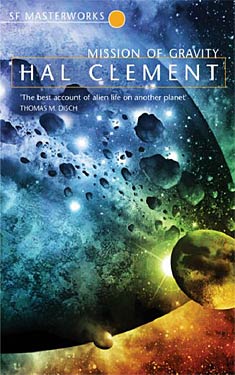GMRC Review: Mission of Gravity by Hal Clement
 Scott Lazerus came to Worlds Without End looking for a good list of books. He found David Pringle’s Best 100 Science Fiction Novels to his liking and is currently working his way through the list. He has posted a bunch of reviews for WWEnd including several for the GMRC. Be sure to check out Scott’s excellent blog series Forays into Fantasy too!
Scott Lazerus came to Worlds Without End looking for a good list of books. He found David Pringle’s Best 100 Science Fiction Novels to his liking and is currently working his way through the list. He has posted a bunch of reviews for WWEnd including several for the GMRC. Be sure to check out Scott’s excellent blog series Forays into Fantasy too!
Hal Clement‘s Mission of Gravity (1954) is a love letter to science. Serialized in Astounding in 1953, it’s often pointed to as a prototypical “hard” science fiction novel of the ‘50s, with the story driven more by the solution of scientific problems and the achievement of scientific discovery than by character or plot. Clement, a science teacher, specialized in this sort of science fiction, which may be why he seems to be one of the more neglected of the Grand Masters from the perspective of modern SF fans. But Clement’s third novel is a cut above much of the hard SF of the time, which has a tendency to become dated as science advances, because of the way Clement melds the scientific explanations with the characters’ motivations, which in turn drive the plot and create suspense and interest in the story.
Another way Clement infuses his narrative with science is by making the exploration of the setting a major source of interest for the reader, as well as the source of the obstacles that must be overcome in order for the plot to advance and the characters to achieve their goals. The protagonists’ quest involves overcoming the environmental difficulties created by the setting itself. That setting is the planet Mesklin, a disc-shaped world with an intense gravity field. The gravity ranges from three times that of Earth’s along the equator (the “rim”) to seven-hundred times at the poles. Intelligent life, capable of living under the extreme gravity, has developed there. The Mesklinites are hydogen-breathing, chitin-shelled, caterpillar-like creatures fifteen inches long and two inches in diameter, with “dozens of suckerlike feet,” and pincers functioning as hands. The point-of-view of the novel is that of Barlennan, a merchant trader and leader of a Mesklinite crew that sails the methane oceans of the storm-tossed planet in search of profit.



















 Full Details
Full Details


